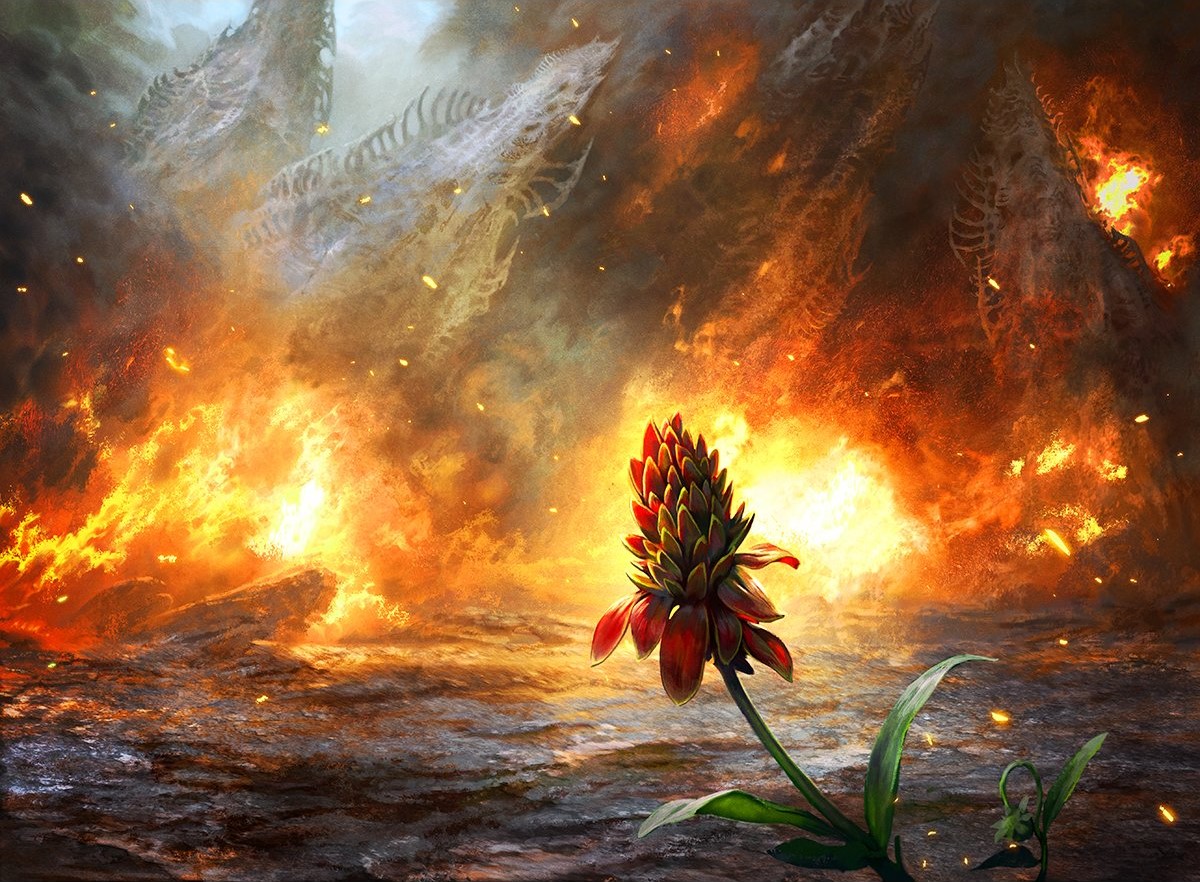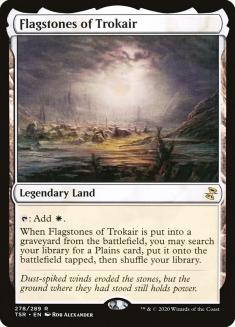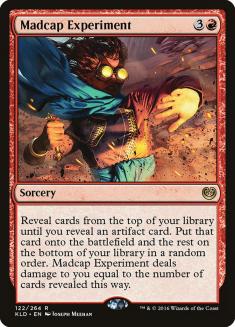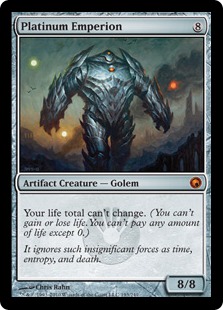I don’t often get to relish an under-discussed prediction being correct when it comes to the chaotic ebbs and flows of various Constructed metagames, but recently I’ve been awfully proud of myself for seeing Cleansing Wildfire ahead of time as a potential key element of a lot of fair Modern decks.
It’s been a long time coming for fair midrange decks to have a real way to fight back against big-mana decks, from when every single one had to play Fulminator Mage to now, when Field of Ruin and Cleansing Wildfire offer incidental hate for nonbasic lands that isn’t as overwhelming as Wasteland, but easier to include in a wide variety of decks than Blood Moon.
For many years, it was a basic tenet of Modern that big-mana decks like Mono-Green Tron would invariably overwhelm normal control decks like Jeskai Control, but that paradigm is totally changed now. These control decks are more than capable of winning, not just sideboard games but Game 1 as well. Even midrange decks are picking up Cleansing Wildfire in higher numbers to tilt a once-bad matchup more in their favor.
But it’s not all grins and “I told you so”s. There’s not a lot of productive value in that sort of retrospective analysis. So why did this particular prediction work out, and why is it such a key part of Modern today? What can we add to our mental model of forecasting to improve our predictive abilities in the future? Additionally, what other decks could potentially make use of this cheap cantrip to get ahead against some of the format’s most fearsome decks?
Also, Flagstones of Trokair? How did I not see that one coming?!
Creatures (4)
Planeswalkers (7)
Lands (19)
Spells (30)

This maindeck has become extremely stock over the course of the last few weeks. And for good reason! It showcases a fantastic blend of interactive strength and cute synergies that make for an excellent, well-rounded package. If you love playing with big blue planeswalkers, this is your deck. There’s no question about it. Here’s a deck that every control player can easily fall in love with.
But it’s important to investigate what allows a comparatively fair deck without the busted draws of a combo or big-mana deck to compete. When many people are casting Primeval Titan off Cavern of Souls or jamming their entire deck into the graveyard with Undercity Informer, there’s comparatively little reason to be stuck casting Remand and Teferi, Hero of Dominaria. After all, wouldn’t you rather just run out your broken cards from 2019 and 2020?
Despite the disparity between a card like Uro, Titan of Nature’s Wrath and, well, normal Magic cards, somehow the plain old control deck still shows signs of life. And a huge part of that is the fact that key role-player Cleansing Wildfire gets to sit in the maindeck here. Whenever you get to play maindeck hate cards without diluting your gameplan in a significant way, there’s reason to be at least a little bit intrigued.
Now, on its own, Cleansing Wildfire is a reasonable card. It works as a very nice hate piece against opposing Urzatron decks, and targets value lands like Blast Zone or Field of the Dead to keep them from uncounterably messing with your plans.
When you combine Cleansing Wildfire with Path to Exile, suddenly you have a very real chance of running your opponent out of basic lands and turning your Cleansing Wildfires into the best Stone Rain ever. Your Path to Exiles even become better versions of Swords to Plowshares, too! With Snapcaster Mage in the mix, your opponent is likely to run out of basic lands far before you run out of cards whose only drawback is allowing them to search out a basic land.
But what really makes this card sing is the synergy with Flagstones of Trokair. A niche land printed fourteen years ago, Flagstones has been a tiny part of Modern for some time, popping up here and there alongside cards like Boom // Bust. But here, it combines with Cleansing Wildfire to turn the latter into a cantrip Rampant Growth in a color combination that never gets that effect. You simply target your own Flagstones, search up a basic land and a Plains, put them onto the battlefield tapped, draw a card, and chuckle at the clean value you just garnered.
A cantrip Rampant Growth that thins your deck of two lands and makes it that much richer with powerful spells is a great innovation, indeed. It’s almost like a jury-rigged version of Uro, if you squint really hard. Sure, it’s not as powerful, but it does what it needs to without warping your deck too much.
Now, the sideboard is up in the air right now. It would be reasonable to include four copies of Madcap Experiment and two copies of Platinum Emperion in order to immediately knock out opposing decks like Izzet Prowess, Rakdos Death’s Shadow, Gruul Midrange, Jund Midrange, and Burn. Of course, some of those decks might end up having between one and three outs to a resolved Madcap Experiment, but in effect resolving this four-mana spell wins the game. However, the deck is already very rich with four-mana spells, and adding more expensive haymakers isn’t always the answer. If these matchups are giving you grief and you want to try to swipe massive win percentage with a cute sideboard juke, this is your answer.
Aside from that, the normal cast of characters makes an appearance. One could choose to use Rest in Peace over Relic of Progenitus, but Relic allows for lower-cost graveyard disruption, can draw you a card, and doesn’t immediately shut off your Snapcaster Mages. Nexus of Fate is a quick answer to Dimir Mill that also lets you win the game in a couple of corner-case scenarios. And Mystical Dispute, Aether Gust, Supreme Verdict, and such are classic standby inclusions in any blue deck’s sideboard.
If you have the urge to cast Teferi, Hero of Dominaria again, this is your deck!
Now, Jeskai is not the only one to employ Cleansing Wildfire with competitive success, as we’ve seen in past weeks. It’s popping up in a number of different decks, including Jund Midrnge, Rakdos Death’s Shadow, and Izzet Prowess. Most new cards, even ones that look like they could be useful tools in a format like Modern, don’t catch on quite as well as this one. There are a few lessons to be gleaned from this successful prediction that will help all players learn to better identify future trends in Modern. Of course, these lessons transfer to other formats, but each format has its own unique flavor that requires specific attention.
1. Cheaper is better!
This should be a simple heuristic that’s easy to keep in mind. Why do cards like Molten Rain, Fulminator Mage, or Blood Moon, even though they’ve been perpetual parts of various sideboards in Modern for years, never quite topple Mono-Green Tron? Why do they get included in sideboards when they don’t actually move the needle that much in the matchup? The problem is that three mana is simply not sufficient when you’re trying to combat the Urzaron. It’s not a good policy to have your best card be one that comes down after the opponent has executed their main gameplan when you’re on the draw.
Two mana is the sweet spot in Magic, especially in Modern, where your cards can still be chisels rather than sledgehammers. Once you’re spending three mana, your cards had better have a massive impact on the game. For minor hosing effects like land destruction, you’re not going to be happy casting these cards by the mid-game.
In the future, when there’s an interesting new card printed that you suspect will be strong in Modern, the bar for impact becomes tremendous at three or more mana. The card needs to be able to win the game by itself, or do something critical for a linear deck. It’s easy to put lots of one- and two-mana cards in your deck. A cool new one-mana spell is likely an easy sell for Modern. Keep that in mind.
2. Hate cards you can maindeck are great!
Sideboards are as stretched thin as ever. There’s simply always a huge benefit to having effects that you’d like to have in your sideboard, that you can effectively play in your maindeck. We’ve seen this before, with cards like Kolaghan’s Command, Scavenging Ooze, and Relic of Progenitus, and as more modal spells get printed we’ll continue to see it.
When you get to play a nineteen-card sideboard because you’re simply willing to put some of your sideboard hate cards into your starting 60, you gain a small but significant advantage in a format built on the concept of linear decks against fair decks and the need to maximize favorable matchups.
If Mono-Green Tron ever becomes a significant part of the format again, expect maindecked Cleansing Wildfires to become the norm for decks like Rakdos Death’s Shadow or any Prowess strategies. The mere existence of the card pushes down the attractiveness of Mono-Green Tron in general now, since free wins in Game 1 are that much fewer and further between.
3. Draw. A. Card.
Cantrips are the way of the future. You simply have to keep the cards flowing. If you’re a linear Prowess deck, you want cantripping instants and sorceries to beef up your Soul-Scar Mages while keeping your hand full. If you’re a non-linear Jund or Jeskai deck, you need to keep digging towards your bombs even as you disrupt your opponents. It’s a bit formulaic at this point, but it will be very challenging for Wizards of the Coast (WotC) to exit this paradigm. Every time another card that cantrips gets printed, it raises the bar that much higher for non-cantripping cards to get into decks.
Additionally, powerful cantrips want to be included in decks with other powerful cantrips. There is synergy inherent in having a high percentage of your cards draw a card. You essentially get to play a leaner deck, with higher relative densities of your bombs. The problem with too many cheap cantrips is that occasionally your deck simply spends too much mana doing nothing but drawing more cards, but cards like Cleansing Wildfire have meaningful effects on the game while doing the same. This trend is going to continue to accelerate and you don’t want to miss it as it’s happening.
Just take a look at this Jeskai deck! Teferi, Time Raveler; Remand; Shark Typhoon; and Cleansing Wildfire all keep the cards flowing. In the sideboard, Confounding Conundrum continues the trend of cantripping hate cards. This is no accident. It’s the only way for a deck without an overwhelming linear gameplan to keep pace. You should always be looking for other cheap interactive cantrips to put in your decks, and new ones should receive special scrutiny.
I’m excited to see where Cleansing Wildfire and its band of ragtag card-neutral brothers go as the Modern format continues to evolve and expand. Every few months, it seems the format is almost unrecognizable, which is a far cry from the format of years past, but it certainly makes for exciting deckbuilding and innovative opportunities to get ahead of the curve! And with 2021 just around the corner, I have little doubt that the next year of Magic’s sets will keep this trend going strong. Stay on your toes!





